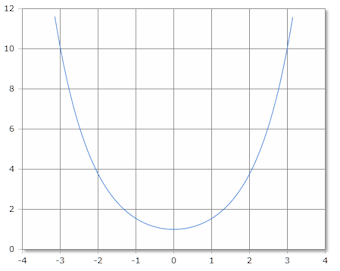Hyperbolischer Kosinus (cosh) Rechner
Berechnung des hyperbolischen Kosinus eines Winkels mit mathematischen Eigenschaften
Geben Sie den Winkel ein und klicken Sie auf Berechnen um den hyperbolischen Kosinus zu ermitteln. Der hyperbolische Kosinus ist für alle reellen Zahlen definiert.

Graphische Darstellung der cosh-Funktion
Hyperbolischer Kosinus
Hyperbolischer Kosinus verstehen
Der hyperbolische Kosinus (cosh) ist eine fundamentale hyperbolische Funktion. Er ist für alle reellen Zahlen definiert und hat wichtige Eigenschaften: Er ist eine gerade Funktion (cosh(-x) = cosh(x)) und sein Wertebereich ist [1, ∞).
📐 Definition
Exponentialform:
📊 Eigenschaften
- • Definitionsbereich: \((-\infty, \infty)\)
- • Wertebereich: \([1, \infty)\)
- • Gerade Funktion: \(\cosh(-x) = \cosh(x)\)
- • Minimum bei \(x = 0\): \(\cosh(0) = 1\)
🔬 Anwendungen
- • Kettenlinie (hängende Seile)
- • Wärmeleitungsgleichung
- • Relativitätstheorie
- • Differentialgleichungen
⭐ Spezielle Werte
- • \(\cosh(0) = 1\)
- • \(\cosh(1) \approx 1{,}543\)
- • \(\cosh(-1) \approx 1{,}543\)
- • \(\cosh(\ln(2)) = 1{,}25\)
Mathematische Eigenschaften
📐 Grundformel
Definition des hyperbolischen Kosinus:
\[\cosh(x) = \frac{e^x + e^{-x}}{2}\] \[\text{für alle } x \in \mathbb{R}\]
Alternative Darstellung: \(\cosh(x) = \frac{1}{2}(e^x + e^{-x})\)
🔄 Wichtige Beziehungen
Zusammenhänge mit anderen Funktionen:
\[\cosh^2(x) - \sinh^2(x) = 1 \text{ (hyperbolische Identität)}\] \[\cosh(x + y) = \cosh(x)\cosh(y) + \sinh(x)\sinh(y)\] \[\cosh(2x) = \cosh^2(x) + \sinh^2(x) = 2\cosh^2(x) - 1\] \[\cosh(-x) = \cosh(x) \text{ (gerade Funktion)}\]
📊 Ableitung und Integration
Differential- und Integralrechnung:
\[\frac{d}{dx}\cosh(x) = \sinh(x)\] \[\int \cosh(x) \, dx = \sinh(x) + C\] \[\int \cosh^2(x) \, dx = \frac{x}{2} + \frac{\sinh(2x)}{4} + C\]
Beachte: Die Ableitung von cosh ist sinh
Praktische Berechnungsbeispiele
📝 Beispiel 1: Grundwerte berechnen
Aufgabe: Berechnung verschiedener cosh-Werte
Berechnung:
\[\cosh(0) = \frac{e^0 + e^{-0}}{2} = \frac{1 + 1}{2} = 1\] \[\cosh(1) = \frac{e^1 + e^{-1}}{2} = \frac{e + \frac{1}{e}}{2} \approx 1{,}543\] \[\cosh(\ln(2)) = \frac{e^{\ln(2)} + e^{-\ln(2)}}{2} = \frac{2 + \frac{1}{2}}{2} = 1{,}25\]
Symmetrie: \(\cosh(-1) = \cosh(1) = 1{,}543\) ✓
📝 Beispiel 2: Kettenlinie (Katenoid)
Aufgabe: Form einer hängenden Kette
Gegeben: Kette mit Parameter \(a = 10\) m
Gleichung:
\[y(x) = a \cdot \cosh\left(\frac{x}{a}\right)\] \[y(x) = 10 \cdot \cosh\left(\frac{x}{10}\right)\] \[\text{Bei } x = 10\text{m: } y = 10 \cdot \cosh(1) \approx 15{,}43\text{m}\] \[\text{Durchhang: } \Delta y = y(10) - y(0) = 15{,}43 - 10 = 5{,}43\text{m}\]
Anwendung: Hängebrücken, Freileitungen, Architektur
📝 Beispiel 3: Wärmeleitungsgleichung
Aufgabe: Lösung einer Differentialgleichung
DGL: \(y'' - k^2 y = 0\) mit \(k = 2\)
Lösung:
\[y(x) = A \cosh(kx) + B \sinh(kx)\] \[\text{Mit Randbedingungen: } y(0) = 1, y'(0) = 0\] \[y(0) = A \cosh(0) + B \sinh(0) = A \cdot 1 + B \cdot 0 = A = 1\] \[y'(x) = Ak\sinh(kx) + Bk\cosh(kx), \quad y'(0) = Bk = 0 \Rightarrow B = 0\] \[\text{Lösung: } y(x) = \cosh(2x)\]
Physik: Temperaturverteilung, Schwingungen, Wellengleichungen
Numerische und geometrische Eigenschaften
📊 Asymptotisches Verhalten
- • Für \(x \to +\infty\): \(\cosh(x) \sim \frac{e^x}{2}\)
- • Für \(x \to -\infty\): \(\cosh(x) \sim \frac{e^{-x}}{2}\)
- • Exponentielles Wachstum für \(|x| \to \infty\)
- • Globales Minimum bei \(x = 0\)
🔢 Reihenentwicklung
- • Taylor-Reihe um \(x = 0\):
- • \(\cosh(x) = 1 + \frac{x^2}{2!} + \frac{x^4}{4!} + \frac{x^6}{6!} + \ldots\)
- • \(\cosh(x) = \sum_{n=0}^{\infty} \frac{x^{2n}}{(2n)!}\)
- • Konvergenzradius: \(R = \infty\)
Vergleich der hyperbolischen Funktionen
sinh(x)
Hyperbolischer Sinus
\(\sinh(x) = \frac{e^x - e^{-x}}{2}\)
Ungerade Funktion
Def: \(\mathbb{R} \to \mathbb{R}\)
cosh(x)
Hyperbolischer Kosinus
\(\cosh(x) = \frac{e^x + e^{-x}}{2}\)
Gerade Funktion
Def: \(\mathbb{R} \to [1,\infty)\)
tanh(x)
Hyperbolischer Tangens
\(\tanh(x) = \frac{\sinh(x)}{\cosh(x)}\)
Beschränkt auf (-1,1)
Def: \(\mathbb{R} \to (-1,1)\)
Geometrische Interpretation
🔵 Hyperbel-Parametrisierung
Einheitshyperbel und cosh/sinh:
\[x^2 - y^2 = 1 \text{ (Einheitshyperbel)}\] \[\text{Parametrisierung: } x = \cosh(t), \quad y = \sinh(t)\] \[\text{Verifikation: } \cosh^2(t) - \sinh^2(t) = 1\] \[\text{Flächenparameter: } t = 2 \times \text{Fläche des hyperbolischen Sektors}\]
Analogie: Wie Kosinus/Sinus den Einheitskreis parametrisieren
💡 Wichtige Eigenschaften der cosh-Funktion:
- Immer ≥ 1: \(\cosh(x) \geq 1\) für alle \(x \in \mathbb{R}\)
- Gerade Funktion: \(\cosh(-x) = \cosh(x)\)
- Minimum bei x = 0: \(\cosh(0) = 1\) ist der kleinste Wert
- Exponentielles Wachstum: Für große \(|x|\) dominiert \(e^{|x|}/2\)
🔬 Anwendungsgebiete der cosh-Funktion:
- Bauingenieurwesen: Kettenlinie (Seile, Kabel, Hängebrücken)
- Physik: Lösungen von Differentialgleichungen (Wärme, Schwingungen)
- Relativitätstheorie: Lorentz-Transformation und Rapidität
- Mathematik: Hyperbolische Geometrie und spezielle Funktionen
Vollständige Taylor-Reihenentwicklung
🔢 Taylor-Reihe von cosh(x)
Vollständige Reihenentwicklung um \(x = 0\):
\[\cosh(x) = \sum_{n=0}^{\infty} \frac{x^{2n}}{(2n)!} = 1 + \frac{x^2}{2!} + \frac{x^4}{4!} + \frac{x^6}{6!} + \frac{x^8}{8!} + \ldots\] \[\text{Konvergenzradius: } R = \infty\] \[\text{Nur gerade Potenzen: charakteristisch für gerade Funktionen}\]
Beachte: Nur gerade Potenzen, da cosh eine gerade Funktion ist
Praktische Integralformeln mit cosh
| Integral | Stammfunktion | Anwendung |
|---|---|---|
| \(\int \cosh(x) dx\) | \(\sinh(x) + C\) | Grundintegral |
| \(\int \cosh^2(x) dx\) | \(\frac{x}{2} + \frac{\sinh(2x)}{4} + C\) | Quadratische Form |
| \(\int x \cosh(x) dx\) | \(x \sinh(x) - \cosh(x) + C\) | Partielle Integration |
| \(\int \frac{1}{\cosh^2(x)} dx\) | \(\tanh(x) + C\) | Reziproke Form |
acos - Arkuskosinus
acot - Arkuskotangens
acsc - Arkuskosekans
asec - Arkussekans
asin - Arkussinus
atan - Arkustangens
atan2 - Arkustangens von y/x
cos - Kosinus
cot - Kotangens
csc - Kosekans
sec - Sekans
sin - Sinus
sinc - Kardinalsinus
tan - Tangens
hypot - Hypotenuse
deg2rad - Grad in Radiant
rad2deg - Radiant in Grad
Hyperbolik
acosh - Arkuskosinus hyperbolikus
asinh - Areasinus hyperbolikus
atanh - Arkustangens hyperbolikus
cosh - Kosinus hyperbolikus
sinh - Sinus hyperbolikus
tanh - Tangens hyperbolikus
Logarithmus
log - Logarithmus zur angegebene Basis
ln - Natürlicher Logarithmus zur Basis e
log10 - Logarithmus zur Basis 10
log2 - Logarithmus zur Basis 2
exp - Exponenten zur Basis e
Aktivierung
Softmax
Sigmoid
Derivate Sigmoid
Logit
Derivate Logit
Softsign
Derivate Softsign
Softplus
Logistic
Gamma
Eulersche Gamma Funktion
Lanczos Gamma-Funktion
Stirling Gamma-Funktion
Log Gamma-Funktion
Beta
Beta Funktion
Logarithmische Beta Funktion
Unvollstaendige Beta Funktion
Inverse unvollstaendige Beta Funktion
Fehlerfunktionen
erf - Fehlerfunktion
erfc - komplementäre Fehlerfunktion
Kombinatorik
Fakultät
Semifakultät
Steigende Fakultät
Fallende Fakultät
Subfakultät
Permutationen und Kombinationen
Permutation
Kombinationen
Mittlerer Binomialkoeffizient
Catalan-Zahl
Lah Zahl